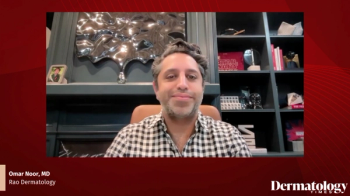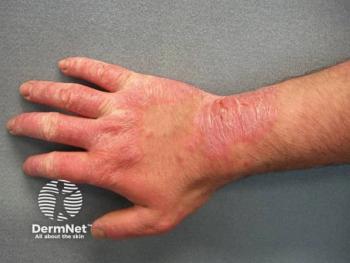
Cracking the Code on Chronic Hand Eczema
Key Takeaways
- CHE presents with varied symptoms and significant occupational and quality of life impacts, requiring a multifaceted diagnostic approach.
- Diagnosis is complicated by mixed etiologies and overlapping pathophysiologic pathways, necessitating detailed history-taking and diagnostic aids.
Chronic hand eczema poses diagnostic challenges and impacts quality of life, but emerging JAK inhibitors offer promising new treatment options.
Chronic hand eczema (CHE) remains a significant dermatologic concern due to its multifactorial etiology, high morbidity, and lack of FDA-approved treatments for moderate to severe cases.1 At the 2025 Fall Clinical PA/NP conference in Orlando, Florida, Andrea Murina, MD, and Linda Stein Gold, MD, led a focused session on the diagnosis, burden, and future management options for CHE.2
Clinical Overview
Patients with CHE may not have constant symptoms but experience periodic flares. As Murina stated, “CHE has to persist for at least 3 months, or it has to recur greater than 2 times in a 12-month period. So they don’t have to have the eczema all year.”
Clinically, CHE presents with a variety of symptoms, including pruritus, pain, fissures, stinging, burning, and sleep disturbances. The disease can negatively affect mood and quality of life and often carries a significant occupational burden. The morphology is varied, with erythema, scaling, hyperkeratosis, vesicles, and nail dystrophy frequently observed.
Diagnostic Challenges
CHE frequently involves a mixed etiology, including irritant contact dermatitis, allergic contact dermatitis, atopic dermatitis, and protein contact dermatitis. The presence of overlapping pathophysiologic pathways, such as Th1, Th2, Th17, and Th22, adds complexity to diagnosis and treatment.
A careful history and physical exam are essential. Diagnostic aids may include KOH prep for fungal involvement, patch testing for allergens, prick testing for protein exposures, biopsies, and cultures for suspected infection.
Stein Gold emphasized the importance of detailed history-taking, noting, “It does take a little bit of a history to try to understand and really tease out exactly what’s going on.”
The German CARPE registry highlighted the prevalence of mixed subtypes, showing that 50% of CHE cases involve more than 1 etiology. This underscores the importance of a multifaceted diagnostic approach tailored to each patient’s history and exposure risks.
New Therapeutic Developments
Currently, there are no FDA-approved therapies specifically for moderate to severe CHE. Traditional treatment has relied heavily on topical corticosteroids, which pose risks such as skin atrophy, especially with long-term use on the hands.
Emerging therapies target the JAK-STAT pathway, which plays a central role in the inflammatory processes of CHE, regardless of etiology.
Delgocitinib (Anzupgo; Leo Pharma)
Delgocitinib, a topical pan-JAK inhibitor, has shown promise in clinical trials. In a 16-week study, about 40% of participants with moderate to severe CHE achieved “clear” or “almost clear” status. The improvement began as early as week 1 and was maintained through 36 weeks in a long-term extension study.
Stein Gold explained, “We don’t see the systemic manifestations of a broad-spectrum JAK inhibitor” when used topically, and added, “We found very, very limited sting or burning when you applied it topically.”
Delgocitinib also demonstrated minimal systemic absorption—even in studies involving extensive skin application—suggesting a favorable safety profile for long-term use.
Ruxolitinib (Opzelura; Incyte) Cream
Ruxolitinib, a topical JAK1/2 inhibitor already approved for atopic dermatitis, has also been evaluated in patients with CHE. In a phase 2 study, patients showed statistically significant improvement compared to placebo, with positive safety and tolerability outcomes.
Murina acknowledged, “I think they do offer a benefit over the classic steroids that we often go through very quickly, and that’s the problem.”
Looking Ahead
Indirect comparisons have suggested that topical JAK inhibitors may offer efficacy comparable to systemic agents like dupilumab, particularly in non-atopic CHE subtypes. Ongoing trials are expanding investigations into adolescent populations and broader adult cohorts.
Conclusion
CHE is a multifactorial, burdensome disease that requires accurate diagnosis and careful therapeutic planning. With limited approved options, emerging topical JAK inhibitors such as delgocitinib and ruxolitinib present promising, well-tolerated alternatives for patients with moderate to severe disease. As further evidence accumulates, these agents may offer a new standard of care in managing this complex dermatologic condition.
References
1. Weisshaar E. Chronic hand eczema. Am J Clin Dermatol. 2024;25(6):909-926. doi:10.1007/s40257-024-00890-z
2. Murina A, Stein Gold L. Seminar-in-depth: Turning a corner in diagnosis and treatment of chronic hand eczema. Presentation at Fall Clinical PA/NP 2025 Conference; May 30-June 2, 2025; Orlando, Florida.
Newsletter
Like what you’re reading? Subscribe to Dermatology Times for weekly updates on therapies, innovations, and real-world practice tips.



















